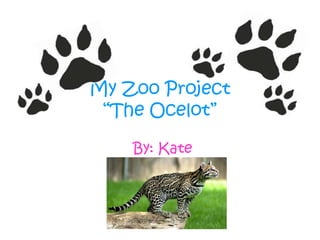
My zoo project final
- 1. My Zoo Project“The Ocelot” By: Kate
- 2. Ocelot Taxonomy The ocelot family is the felidae. The ocelot order is the carnivora. The ocelot class is the mammalia. The ocelot phylum is chordates or number 11. The ocelot kingdom is animal.
- 3. Physical Characteristics What does the ocelot look like? It is a tan colored mammal with black spots all over the body with a white stomach and ringed tail. They also can range in color from light yellow to reddish grey, with dark spots and stripes. It has sleek fur, rounded ears and relatively large front paws. The ocelot is 26-39 inches in body length, 12-18 inches in tail length and it weighs 24-35 pounds. The ocelot is similar in appearance to a domestic cat. Ocelot compared to man
- 4. More Physical Characteristics What are the differences between male, female and young ocelot? Male ocelots are larger than females and weigh about 4 pounds more than females. Females mature at 18 months and breed to about 13 years. Males mature at 15 months and breed to 15 years. The young ocelot, called kittens, have a darker color than mature ocelots. What are other characteristics of the ocelot? The ocelot meows for vocalization. Male and Female Ocelot Ocelot Kitten
- 5. Reproduction How long is gestation? The ocelot gestation ranges from 70 to 90 days. How many young are born at a time? There can be 1 to 4 kittens born at a time, but usually there is just one or two. Who cares for the young? The female ocelots take care of the young. How long do the young stay with the parents? Female stay from 18 to 20 months and males stay for 30 months. Once the young are a few months old, they begin to accompany the mother on hunting trips. When they are old enough, the young ocelot leaves the mother and goes on its own.
- 6. Habitat Ocelots can be found throughout Central and South America, living in both dry and tropical areas which include rainforest and chaparral. The ocelot is primarily terrestrial. Occasionally, it is arboreal. The ocelot is territorial. The ocelot nests in tree boughs and hollow trees or a den that is well protected in dense thicket or brush. The ocelot status is endangered. Ocelots were first listed as an endangered species in 1973 from humans hunting the ocelot for its fur.
- 7. Food An ocelot eating a lizard What does the ocelot eat? The ocelot eats rodents, birds, snakes, iguanas, lizards, fish and land tortoises. What are the ocelot’s predators? The ocelots predators are the bobcats, jaguars, lions, coyotes, eagles and humans.
- 8. Interesting Facts One interesting fact is the ocelots do not have good teeth for chewing, so they tear pieces from their food and swallow them whole. Another fact is that ocelot came from the Mexican Aztec word Tlalocelot which means field tiger.
- 9. Ocelots have retractable claws so the claws can remain sharp for both seizing and holding prey. The dappling of the coat resembles patterns from light passing through brush and then hitting the animal, allowing the ocelot to blend in with its surroundings. The ocelot has large eyes. The ocelot’s eyesight is six times better than human’s, so it can track down prey at night. Ocelots have long whiskers to help it’s way around. 5. Ocelots have sharp teeth for killing their prey. Physical Adaptations and How They Aid Survival
- 10. Physical Adaptations and How They Aid Survival The ocelot has powerful legs, making it one of the fastest cats. The ocelot has a good sense of smell better than humans but not as good as dogs. This aids hunting prey. Ocelots have a white spot on their ears to fool predators. The ocelot have small ears, but amazing hearing, to seek prey and hide from predators. Ocelots are strong swimmers which helps them evade danger.
- 11. Behavioral Adaptations and How They Aid Survival The ocelot sharpens their retractable claws on trees. This helps them when they hunt for prey at night. The ocelot is nocturnal, so it can hide from predators in the day and hunt during the night. During the day they rest in trees or other dense foliage. They do this to get ready for a night’s hunt. 4. The ocelot is territorial. It guards an area of land and protects it from predators. It does this to decrease competition for hunting at night. Ocelots thrive in captivity, where they may live more than 20 years, as compared to 7-10 years in the wild.
- 12. Improvements to the Cleveland Zoo Habitat The habitat should have been bigger because an ocelot’s territory averages between 2-18 square kilometers. 2. The ocelot should have a natural water source and live prey instead of water and food in bowls. 3. I didn’t like how the ocelot was enclosed by wire bars. I would make the habitat more natural to make the ocelot more comfortable. I would put more vegetation and dense brush in the habitat because the ocelot prefers this type of environment, especially during the day, so it can hide. 5. I would provide a water source for the ocelot, so it would have a place to swim. The ocelot likes the water unlike most cats.
- 13. The Ocelot at the Cleveland Zoo.